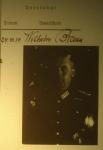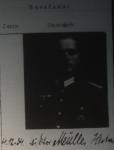-
Posts
4,908 -
Joined
-
Last visited
-
Days Won
97
Content Type
Profiles
Forums
Blogs
Gallery
Events
Store
Everything posted by Dave Danner
-
A few: Not completely sure, but appears to be Eberhard Freiherr Göler von Ravensburg (1870-1918). A Hauptmann in LGR 109 in 1914, he was promoted to Major in October 1914, and served with several Baden regiments before being killed as commander of RIR 109. Appears to be Karl Voelkle, from IR 170. There were lots of Westernhagens, but I'm pretty sure this is Thilo Udo Max Eugen von Westernhagen. He seems to be the one with the right rank and Hesse regimental connection. Heinrich von Westernhagen was a Major in IR 115 in 1914, but was promoted to Oberstleutnant on 8.11.14. Hans Melchers
-
Another Wilhelm Braun: Braun, Dr. jur. et rer. pol. Wilhelm Gustav Albrecht Bernhard born 10 July 1895 in Karlsruhe, Baden Hptm. 1.8.33 Maj. 1.8.37 OTL 1.12.40 Oberst 1.6.42 Kdr. MG-Bataillon 4, 1.9.39-28.6.42 [probably since 1937] Kdr. Unterführer-Lehrgang (mot.) Wehrkreis III, 17.7.42-4.3.43 Kdr. Panzer-Grenadier Regiment 112, 5.3.43-15.8.43 Kdr. Grenadier-Ersatz-Regiment (mot.) 3, 8.9.43-30.11.44
-
That looks like three stars on the flag. The Syrian flag only had three stars, like Iraq's, from 1932-1958 and from 1961-1972. Do you think it's likely the slide is that old? If not then it's probably Iraqi.
-
One consideration regarding the EK: We have often said that the EK, while technically a Prussian award, was viewed as a quasi-German award through World War I. This of course reflects Prussia's role in creating Germany and the fact that from 1871 to 1918 the King of Prussia was also the German Emperor. But I wonder if there is also another psychological factor. Outside of maybe a brief period from its founding in early 1813 to the Battle of the Nations later that year when Napoleon lost his remaining German allies, I don't think there was a period where a German could get the Iron Cross for killing other Germans. This isn't the case for other state awards, of Prussia or any of the other German states, some of which predate 1813 and others which were awarded for the 1848-49 revolutions and the 1866 war, which pitted German against German. Grand Duke Friedrich I of Baden, especially, might have seen the "simple" Iron Cross as a modest compromise. His father had sided with Prussia against his own people (including my great-grandfather) in 1848-49, and Friedrich I himself sided with Austria against Prussia in 1866, though somewhat reluctantly. At least with the Iron Cross he was only making a statement against the French.
-

EK 1914 Who got what and when....
Dave Danner replied to Chris Boonzaier's topic in Germany: All Eras: The Iron Cross
They are probably among the ones who turned it around on their medal bars so that Wilhelm's cipher was on the reverse. Also, if you had both the EK and the MVK, you might put the MVK buttenhole ribbon over the EK. Though, what they thought of Prussians as a people and what they thought of the EK might be two different stories. What are Bavarian attitudes toward Prussians like today? When I was in Potsdam in September 2007, I saw a local news broadcast on the opening of the Oktoberfest. The reporter had a good time making fun of the Bavarians and their funny accents, which I found amusing given how harsh his accent sounded. -
I spoke (figuratively) too soon. I can add something: 1. Ldst.-Inf.-Btl. Essen VII/60 became IV./LdstIR 39 on 4.6.16. It later moved to LdstIR 38, becoming its III.Btl. I don't know the exact date, but probably around May 1917, when LdstIR 39 became a Württemberg regiment. That would put it in the 19th, then the 48th Landwehr-Divisions. So if there are unit histories for any of these, those might help. Of course, I have no idea if Freund was still with the battalion when these changes happened, but maybe a unit history would say.
-
According to the Ehrenrangliste, Ostertag died on 23.6.16 in Gent. Ch.d.Gen.St.d.Et.Insp. 4 is listed as his last position. He started the war as a battalion commander in GGR 2, so if someone has a regimental history, that might have more information. On 27 May 1915, he is shown as an OTL v.d. Armee, commanded to the Gesandtschaft im Haag (at least I think it's him; I don't see another OTL Ostertag). So the best I have is sometime after May 1915 and before June 1916. Freund was still listed commander of the Landsturm battalion on 18.9.15 when he received a Patent as Major. He is still a Major z.D. in the 1919 Dienstaltersliste, so the OTL was probably a retirement bump. That's all I can add.
-

Heer Müller, Viktor
Dave Danner replied to hucks216's topic in Germany: All Eras: Signature Database
Viktor Müller born 4.2.1898 in Dieuze, Lorraine Hptm. 1.11.33 Maj. 1.4.38 OTL 1.6.41 Oberst 1.1.43 Bavarian Army, Freikorps and Reichswehr, 26.4.16-31.10.23 Wehrmacht from 21.10.34: Chef 12./IR 104, 1.4.37-31.7.38 Chef 14./IR 104, 1.8.38-Mobilm. Kdr. I./IR 115, 26.8.39-14.9.41 Kdr. I./SchutzenR 126, 28.10.41-15.4.42 Führer-Reserve, 16.4.42-31.8.42 Fhr. PzGrenR 382, 1.9.42-10.11.42 Laz., then Führer-Reserve, 11.11.42-20.7.43 Kdr. PzGrenR 5, 21.7.43-14.1.44 Kdr. FeldjR (mot) 2, 15.1.44-15.9.44 Führer-Reserve, 15.9.44-9.12.44 Fhr. TrÜbPl Schwarzenborn, 10.12.44-4.3.45 Kdt. TrÜbPl Schwarzenborn, 5.3.45-Kriegsende -
Alois Becker Hptm. on 1.10.38, Maj. on 1.3.42
-

Heer Heyl, Friedrich
Dave Danner replied to hucks216's topic in Germany: All Eras: Signature Database
Generalmajor Friedrich Heyl http://www.geocities.com/~orion47/WEHRMACHT/HEER/Generalmajor/HEYL_FRIEDRICH.html -

Heer Bruell, Friedrich
Dave Danner replied to hucks216's topic in Germany: All Eras: Signature Database
char. Generalmajor Fritz Brüll. http://geocities.com/~orion47/WEHRMACHT/HEER/Generalmajor/BRUELL_FRIEDRICH.html -

Heer Beseler, Lothar
Dave Danner replied to hucks216's topic in Germany: All Eras: Signature Database
I think it is Beseler, not Befeler. That darned long s (ſ). Lothar Beseler, born 7.2.1908, Hptm., IR 22, on 1.3.38. Killed in action on 3.9.1939 in Poland as company commander, 7./IR 151. -

Polizei Help with Ribbonbar
Dave Danner replied to Thierry's topic in Wehrmacht Medals, Decorations & Awards
Here is a larger version of the ribbon bar. There is definitely a device on this one. I don't think it is the same ribbon as on his other Feldspange, either - the patterns don't really match well. With the round device, this may be the Slovak Bravery Medal.






